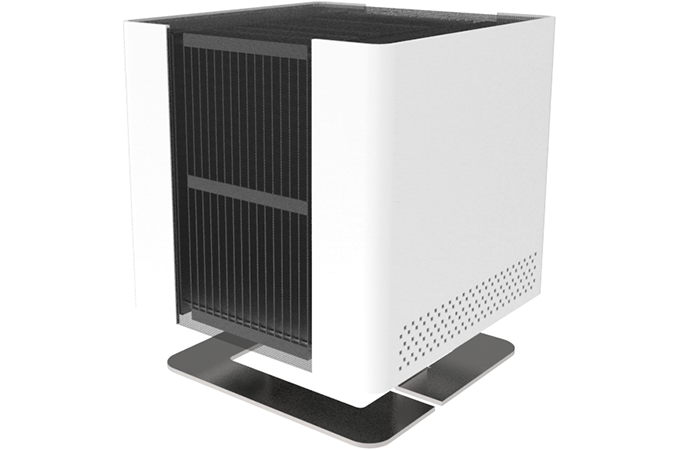Calyos NSG Cube: Passively Cooled SFF PC with Intel Core and GeForce GTX 1060
by Anton Shilov on December 20, 2016 4:00 PM EST
Calyos plans to display its first passively cooled small form-factor gaming PC at CES early next month. The NSG Cube promises to pack an Intel Core processor as well as a GeForce GTX 1060 graphics card to offer a decent level of performance in games by a system that produces absolutely no noise.
Apart from performance, a lot of gamers nowadays demand computers in compact form-factors and even more people want their systems to be quiet. Developers of key components of PCs understand their customers, which is why companies like AMD, Intel, NVIDIA introduced very power-efficient CPU and GPU architectures as well as SFF designs in the recent years. Meanwhile, it is hard to wed a small form-factor with passive cooling: the former needs airflow and the latter needs either large radiators or liquid cooling (which means large radiators in the end). Apparently, this is exactly what Calyos is trying to do with its NSG Cube.
| Calyos NSG Cube at Glance | ||||
| Component | TDP | |||
| CPU | Intel Core in LGA1151 form-factor | 35 W (?) | ||
| PCH | Intel Z170 | 6 W | ||
| Motherboard | ASUS Z170I Pro Gaming | Over 6 W | ||
| GPU | ZOTAC GeForce GTX 1060 Mini-ITX | 120 W | ||
| Other | DRAM, SSD/HDD | 39 W | ||
| Total TDP | - | ~200 W | ||
At present, the amount of information that we have in hand (thanks to FanlessTech) is scarce. What we do know is that the system is based on the ASUS Z170I Pro Gaming motherboard in a Mini-ITX form-factor and uses the ZOTAC GeForce GTX 1060 Mini-ITX graphics adapter. The passively cooled SFF PC will have TDP of 200 W, which is not a lot and given the fact that the video card has TDP of 120 W, this leaves 80 W for the CPU (no overclocking here), PCH, DRAM, SSD and so on. The NSG Cube is designed to be small but uses aluminum radiators to cool down its components. At this point Calyos has not stated if the power supply is internal or external - given the use of the ASUS motherboard, we would suspect an internal unit, either SFX or proprietary.
Calyos will demonstrate its NGS Cube at CES in early January. Pricing and ETA of the system are unclear at this point, but the PC will be available commercially.
Related Reading:
Source: FanlessTech
















21 Comments
View All Comments
casperes1996 - Tuesday, December 20, 2016 - link
This is quite reminiscent of the Apple G4 Cubecasperes1996 - Tuesday, December 20, 2016 - link
As in cooling philosophy, not design or specs of course*edit button
mobutu - Tuesday, December 20, 2016 - link
no, this is reminiscent ofhttp://www.streacom.com/products/db4-fanless-chass...
Gadgety - Wednesday, December 21, 2016 - link
Yes, totally agree. Even the feet. The Streacom design is more elegant, though. This looks interesting. Like a giant heat sink with a side wrapping. If both CPU and GPU are passively cooled it's a major step that Streacom didn't manage.guidryp - Tuesday, December 20, 2016 - link
Kind of reminds me of the Streacom DB4 case:https://techreport.com/news/30224/streacom-db4-is-...
But this looks more like it is going for wide open mesh instead of heatpipes.
So eventually it will accumulate dust. I like the DB4 better.
eldakka - Tuesday, December 20, 2016 - link
I like the DB4 as well, however everything I've been able to find on it indicates that the heatpipes are for the CPU, not for the GPU.It'd be much better if they had a GPU heatpipe setup as well.
eldakka - Tuesday, December 20, 2016 - link
(edit!)Not to mention when I did a cost of building such a system, the DB4 case was the single most expensive component of the build (more than the MB, or CPU, or RAM, or GPU or 512GB SSD)
Gadgety - Wednesday, December 21, 2016 - link
If it managed both GPU and CPU it would be worth it. The case looks very stylish and will be on display for a long time.guidryp - Wednesday, December 21, 2016 - link
Odd. All 4 sides are >2LB aluminum heatsinks each of the 4 rated at 65Watts of heat dissipation.It comes standard with a connector to one side, for 65W CPUs, and there is a kit for using 2 sides on the CPU for up to 105 Watts.
It seems like you could use 1 panel for CPU (65W) and 2 Panels for ~100W GPU if routing could be figured out.
eldakka - Wednesday, December 21, 2016 - link
The documentation (sales literature on their website) says up to 120W, based on that I assumed that only 2 sides were heat sinks.However that might just be the the standard unit, maybe the other sides can be replaced by heat sink sides (at additional expense!) ?